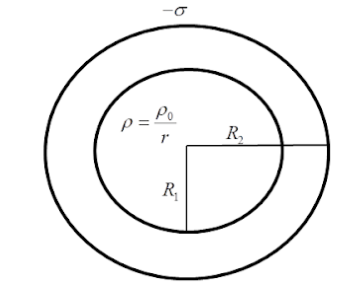
A solid sphere of radius ${{R}_{1}}$ and volume charge density $\rho =\dfrac{{{\rho }_{0}}}{r}$ is enclosed by a hollow sphere of radius ${{R}_{2}}$ with negative surface charge density $\sigma $, such that the total charge in the system is zero, ${{\rho }_{0}}$ is positive constant and $r$ is the distance from the centre of the sphere. The ratio $\dfrac{{{R}_{2}}}{{{R}_{1}}}$ is ?
Answer
505.5k+ views
Hint:Surface charge density is the measure of charge per unit area. Volume charge density is the measure of charge distributed over a volume. Keep in mind the difference between sphere and a hollow sphere.
Complete step by step answer:
The charge density is a measure of charge per unit area or volume over which it is distributed. It can be either positive or negative.
Linear charge density: Linear charge density is represented by ratio of charge and length over which it is distributed. It is represented by $\lambda =\dfrac{q}{l}$
Surface charge density: Surface charge density is represented by the ratio of charge and the area over which it is distributed. It is represented by $\sigma =\dfrac{q}{A}$
Volume charge density: Volume charge density is the ratio of charge and the volume over which it is distributed. It is represented by
$\rho =\dfrac{q}{v}$
Where $q$ is the charge, $l$ is the length, $A$ is the area of the surface and $v$ is the volume of the body.

Charge on the outer sphere: $-4\pi R_{2}^{2}\sigma $
Charge on the inner sphere: For calculating charge on the inner sphere, let’s assume that the sphere with radius ${{R}_{2}}$ has another shell inside it with radius $r$ and thickness $d$r.The volume of the shell is equal to surface area $\times $ thickness.
Volume of shell: $\int{4\pi {{r}^{2}}dr}$
Charge : $\int{dQ}$=$\int{\rho \times 4\pi {{r}^{2}}dr}$
$\int{dQ}$=$\int{\dfrac{{{\rho }_{0}}}{r}\times 4\pi {{r}^{2}}dr}$........(given that $\rho =\dfrac{{{\rho }_{0}}}{r}$)
$\int{dQ}$=$\int{{{\rho }_{0}}\times 4\pi rdr}$
Integrating from $0$ to $Q$ and from $0$ to ${{R}_{1}}$, we get
$\int\limits_{0}^{Q}{dQ}=\int\limits_{0}^{{{R}_{1}}}{{{\rho }_{0}}\times 4\pi rdr}$
$\Rightarrow Q=2\pi {{\rho }_{0}}R_{1}^{2}$
Therefore the charge on the inner sphere is $2\pi {{\rho }_{0}}R_{1}^{2}$. According to the question, total charge in the system is zero.
Hence, charge on outer sphere+charge on inner sphere=0
$(-4\pi R_{2}^{2}\sigma )+2\pi {{\rho }_{0}}R_{1}^{2}=0$
$\Rightarrow 2\pi {{\rho }_{0}}R_{1}^{2}=4\pi R_{2}^{2}\sigma $
$\Rightarrow \dfrac{R_{2}^{2}}{R_{1}^{2}}=\dfrac{{{\rho }_{0}}}{2\sigma }$
$\therefore \dfrac{{{R}_{2}}}{{{R}_{1}}}=\sqrt{\dfrac{{{\rho }_{0}}}{2\sigma }}$
Hence, the ratio $\dfrac{{{R}_{2}}}{{{R}_{1}}}$ is $\sqrt{\dfrac{{{\rho }_{0}}}{2\sigma }}$.
Note:Keeping in mind the volume for a shell can save time and solve the problem much faster. When stuck, switch to the basic formulas and start from scratch. Remember there is a difference between a solid sphere and a hollow sphere.
Complete step by step answer:
The charge density is a measure of charge per unit area or volume over which it is distributed. It can be either positive or negative.
Linear charge density: Linear charge density is represented by ratio of charge and length over which it is distributed. It is represented by $\lambda =\dfrac{q}{l}$
Surface charge density: Surface charge density is represented by the ratio of charge and the area over which it is distributed. It is represented by $\sigma =\dfrac{q}{A}$
Volume charge density: Volume charge density is the ratio of charge and the volume over which it is distributed. It is represented by
$\rho =\dfrac{q}{v}$
Where $q$ is the charge, $l$ is the length, $A$ is the area of the surface and $v$ is the volume of the body.

Charge on the outer sphere: $-4\pi R_{2}^{2}\sigma $
Charge on the inner sphere: For calculating charge on the inner sphere, let’s assume that the sphere with radius ${{R}_{2}}$ has another shell inside it with radius $r$ and thickness $d$r.The volume of the shell is equal to surface area $\times $ thickness.
Volume of shell: $\int{4\pi {{r}^{2}}dr}$
Charge : $\int{dQ}$=$\int{\rho \times 4\pi {{r}^{2}}dr}$
$\int{dQ}$=$\int{\dfrac{{{\rho }_{0}}}{r}\times 4\pi {{r}^{2}}dr}$........(given that $\rho =\dfrac{{{\rho }_{0}}}{r}$)
$\int{dQ}$=$\int{{{\rho }_{0}}\times 4\pi rdr}$
Integrating from $0$ to $Q$ and from $0$ to ${{R}_{1}}$, we get
$\int\limits_{0}^{Q}{dQ}=\int\limits_{0}^{{{R}_{1}}}{{{\rho }_{0}}\times 4\pi rdr}$
$\Rightarrow Q=2\pi {{\rho }_{0}}R_{1}^{2}$
Therefore the charge on the inner sphere is $2\pi {{\rho }_{0}}R_{1}^{2}$. According to the question, total charge in the system is zero.
Hence, charge on outer sphere+charge on inner sphere=0
$(-4\pi R_{2}^{2}\sigma )+2\pi {{\rho }_{0}}R_{1}^{2}=0$
$\Rightarrow 2\pi {{\rho }_{0}}R_{1}^{2}=4\pi R_{2}^{2}\sigma $
$\Rightarrow \dfrac{R_{2}^{2}}{R_{1}^{2}}=\dfrac{{{\rho }_{0}}}{2\sigma }$
$\therefore \dfrac{{{R}_{2}}}{{{R}_{1}}}=\sqrt{\dfrac{{{\rho }_{0}}}{2\sigma }}$
Hence, the ratio $\dfrac{{{R}_{2}}}{{{R}_{1}}}$ is $\sqrt{\dfrac{{{\rho }_{0}}}{2\sigma }}$.
Note:Keeping in mind the volume for a shell can save time and solve the problem much faster. When stuck, switch to the basic formulas and start from scratch. Remember there is a difference between a solid sphere and a hollow sphere.
Recently Updated Pages
Master Class 12 English: Engaging Questions & Answers for Success

Master Class 12 Business Studies: Engaging Questions & Answers for Success

Master Class 12 Economics: Engaging Questions & Answers for Success

Master Class 12 Social Science: Engaging Questions & Answers for Success

Master Class 12 Maths: Engaging Questions & Answers for Success

Master Class 12 Chemistry: Engaging Questions & Answers for Success

Trending doubts
What are the major means of transport Explain each class 12 social science CBSE

Which are the Top 10 Largest Countries of the World?

Draw a labelled sketch of the human eye class 12 physics CBSE

Explain sex determination in humans with line diag class 12 biology CBSE

Explain sex determination in humans with the help of class 12 biology CBSE

Differentiate between homogeneous and heterogeneous class 12 chemistry CBSE




